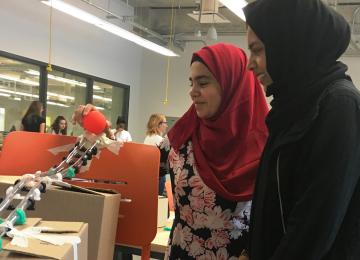
Offered through the Schulich School of Engineering, the BSI is designed for students who are passionate about biology and bioengineering.

The Bioengineering Summer Institute offered through the University of Calgary’s Schulich School of Engineering is a new program designed specifically for students who are passionate about biology and bioengineering. It also offers a new way for students with high school biology to enter first-year engineering. Dr. Qiao Sun, who was instrumental in the program’s creation, recently shared some of her thoughts and insights on BSI.
Dr. Qiao Sun, 30 by 30 Champion for the University of Calgary and part of the 30 by 30 Post-secondary Working Group, was instrumental in the program’s creation. She recently shared some of her thoughts and insights on BSI.
Can you explain how the Biology requisite works and why it was added?
In Canada, it is widely recognized that the ability to achieve gender balance in engineering classrooms is hindered by gender disparity in high school physics classes. While gender stereotypes play a role in students' choices of STEM subjects, structural barriers also exist. For example, schools in Indigenous communities are less likely to offer physics classes due to resource limitations. Many students in the International Baccalaureate program are forced to choose only two science subjects due to scheduling constraints. While we continue to intensify our outreach effort to increase student participation in physics learning, the Biology requisite program is uniquely designed to provide a parallel pathway into engineering for those who are academically strong but are missing physics transcripts. Qualifications are assessed using biology in place of physics. Enrollment in our first-year program is conditioned on the successful completion of the Bioengineering Summer Institute (BSI), a four-week summer program to provide students with the physics fundamentals by leveraging their strong biology background. Design of the BSI curriculum is aimed to ensure student success in the foundational years of our program, which is the guiding principle in designing content, activity, and assessment. This program enables us to tap into a wider talent pool with the promise to reach gender balance and increase diversity in engineering.
In what ways do you think that this will help prepare engineering graduates for the future?
We are hoping that this alternative entry path, together with our outreach effort, will help increase the diversity in our engineering undergraduate student body, which will eventually leads to a steady state that reflects Canadian society’s composition. This new landscape will paint a clear picture for K-12 students that engineering is as relatable as other disciplines. A diverse student body will encourage understanding and dialogue among students with diverse background and belief. It will drive improved and inclusive campus policy and structures. It will contribute to the making of well-rounded engineering graduates who are not only competent in technical capabilities but also the ability to take on society’s challenges
Have there been any obstacles in implementing this? If so, why do you think they’ve arisen?
A main obstacle is related to misconception or misbelief. Some people tend to associate taking physics with excellence, and biology with weakness. There is resistance to the implementation of the new admission path. However, it is our belief that as we continue to accept students through the alternative path, their performance and success will be evident to correct the misconception. From the first cohort in 2019, their academic performance is on par with their peers.
What is the short-term impact? What are you hoping to achieve in 2 to 5 years?
For the first year of the cohort, we have done a research project that investigates the students’ experience and understands how, through the program, they were able to develop their engineering identity. For example, we found that the program was able to help students act like an engineer through their engineering skill development and opportunities to explore future careers. We also found they felt recognized as an engineer by others, and they felt pride and believed in themselves to be an engineer. Research has shown that having a strong sense of engineering identity is particularly important for marginalized students in engineering, so it is promising to see that through the program we were able to build their engineering identity.
We have seen a 4 per cent increase in the female student ratio in our first-year class in 2019. Although it is difficult to isolate the effect of the new alternative admission path, we are hoping to see a continued increase in diversity in our first-year classes in the coming years.
How do you think other programs can learn from this?
We hope, as we continue to implement and adjust details of the BSI, that we will demonstrate the sustained impact on encouraging more participation from under-represented groups of students to pursue engineering education. We hope to collaborate with other schools so that we can remove more barriers. For instance, if one or more engineering schools offered similar programs, students could take the BSI equivalent courses in their hometown schools before entering first year at a different school. Other schools can also design their own alternative pathways appropriate for their own program needs.


